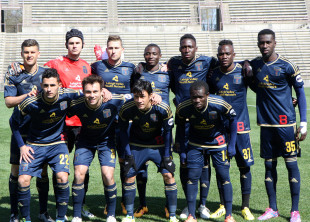Photo: Paul Rudderow
Following Bethlehem Steel may not be for the casual fan. Conventional evaluation by wins and losses is at direct cross purposes to the Steel Project’s reasons for existence. The project must be understood on its own terms: “player development.”
A Steel fan must want to follow the game, its nuances and the growth of individuals over the course of the season, not a won-lost record. They watch to foresee the future of the whole organization, from the YSC Academy U-12s to Philadelphia Union in MLS. The USL Steel component does not stand alone.
It is an unusual, highly specialized sports environment.
The Steel played 30 regular season games in 2016. They started a new, different line-up in 29 of them. They were a poster child for line-up discontinuity.
The stated theory is that, with everyone at all organizational levels following the same principles and the same practices – the “template” as Bethlehem head coach Brendan Burke has repeatedly put it — the discontinuity should be mitigated.
But soccer players are not interchangeable parts, a la Eli Whitney’s famous 20 screwdrivers and boxes of 20 identical parts, each on the table amid twenty government bureaucrats who had previously thought all guns were assembled by gunsmiths, with no two weapons exactly the same.
Evidence, without any reference to wins and losses overall, suggests the mitigation referenced above is imperfect. The “trigger assembly” labelled “Barnetta” (or “Jones”) is different from the one called “Bedoya” (or “Chambers”).
Here are some anecdotal observations demonstrating that.
Preseason Scrimmage: Georgetown, Mar. 20
Look back to Bethlehem’s early friendlies against college clubs.
On Mar. 20, Bethlehem faced Georgetown University. Right back Ryan Richter and right midfielder Eric Ayuk combined in the right channel with smooth, dangerous polish and understanding. The experienced NASL starter with two bouts of MLS experience and the teenager with time in Thailand and some MLS starts and subs in 2015 made the common template theory work beautifully.
But on the other side of the pitch, that was not the case at all. In the left channel Walter Restrepo seemed disinterested, uninvolved and disappointed about not making the game day 18 for the Union, who played that day. He played no defense. Meanwhile, left back Taylor Washington seemed play no offense, seemingly filling his space with a defense-only mindset, understandable for a player nine weeks into his professional career.
The contrast between the two flank channels was stark. The chemistry may have been there on one side, but the other one simply had none. Chemistry would be an issue throughout the year, particularly between occasional Union loanees and Bethlehem regulars.
At Rochester, May 28
The second anecdote comes from an Earnie Stewart Surprise, when the Union took the entire first team on the road trip to Orlando and Colorado in late May.
The Steel traveled to Rochester on the 28th to play the defending USL champions on their home field without their usual game day left back, flank midfielders, and attacking center mid. The first-team travel decision forced the Steel to rely entirely on its own resources, supplemented by three Academy boys “playing up,” one of whom started at left back, Matthew Real.
On paper, they should have lost.
Instead, they came within a gnat’s whisker of ending the Rhinos’ 21-game unbeaten streak at home. Only a late stoppage time misjudgment by goalkeeper Samir Badr saved the New Yorkers’ streak.
Granted, Rochester head coach Bob Lilley did not start his strongest lineup. Presumably, he knew all the circumstances and was rotating his squad. Further, in emergency situations, teams rise above themselves and play above expectations, and the Steel certainly did so.
But forced to rely on a team composed of players who practiced together every day, the smoother and more synchronized nature of play by Bethlehem was noticeable. The Steel played better soccer that day than they usually do.
September with Edu
Finally, consider the Maurice Edu interlude with the Steel. Edu played in three games:
- 30 minutes on Sep. 4 at home against NY Red Bulls 2,
- 94 minutes on Sep. 10 at Charleston, and
- 60 minutes on Sep. 18 at home against Pittsburgh.
When Edu came off against Red Bulls 2 and James Chambers dropped back to defensive mid, the Steel’s play improved — distinctly. Chambers knew his people, and his people knew him. Not only was Edu rusty, but he had rarely, if ever, practiced with the group.
Contrast that to the game against Pittsburgh two weeks later when the Oregon-bound Union’s anti-jet lag measures forced the left-behind first teamers to practice with Bethlehem for two days. When they took the field against Pittsburgh, the opening speed and precision of Bethlehem’s MLS-heavy lineup left the Riverhounds ball-watching, overwhelmed and taken aback. It was the best exhibition of soccer the Steel displayed all year, and it was thoroughly enjoyable to watch.
Conclusion: The template works, but …
The template theory works adequately for player development purposes. It provides many minutes of many different individual game situations that cannot be reproduced with equal effectiveness any other way. It can produce quality soccer that is pleasant to watch when all parties are polished experienced professionals.
Steel game-roster polish and professionalism has not been uniform, however.
The template produces jugeo bonito — the “beautiful game” — when those uneven professionals have practiced together before the game for a day, or even two. Practice seems to matter.


Comments